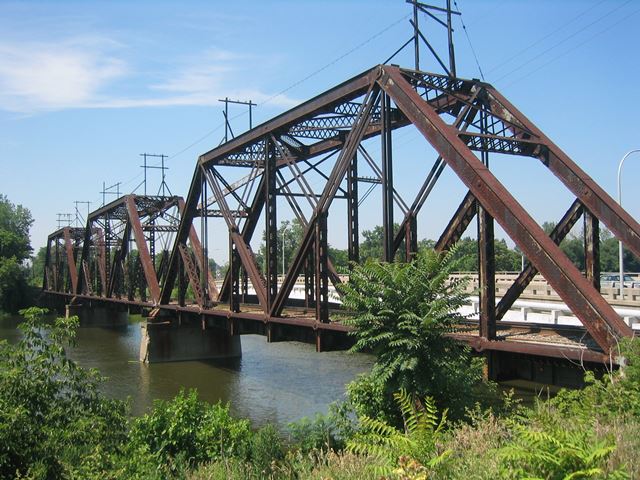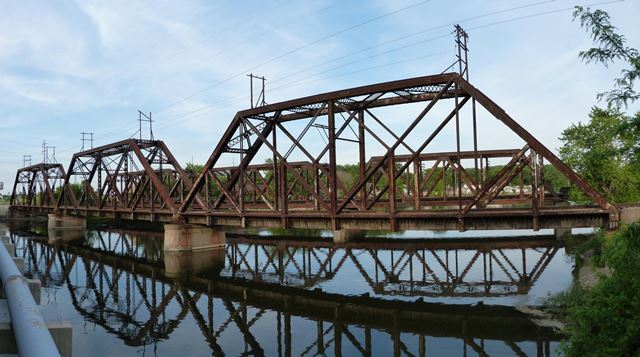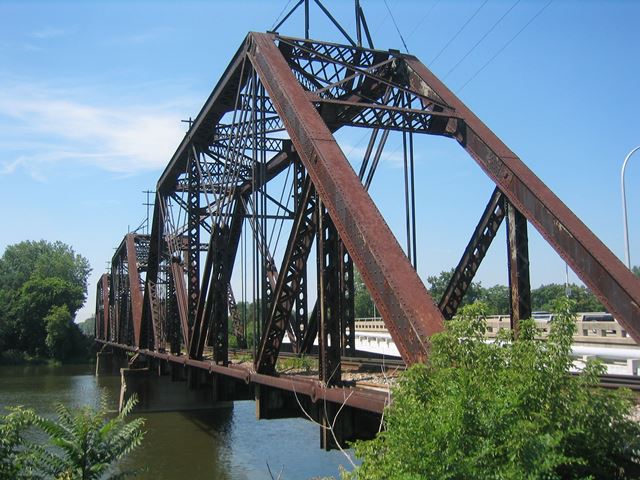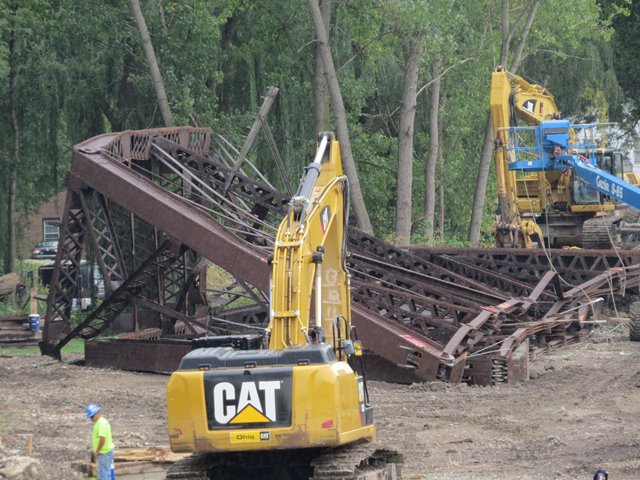We Recommend:
Bach Steel - Experts at historic truss bridge restoration.
BridgeHunter.com Phase 1 is released to the public! - Visit Now
Monroe Norfolk Southern Railroad Bridge

Primary Photographer(s): Nathan Holth and Luke Gordon
Bridge Documented: August 1, 2005
Monroe: Monroe County, Michigan: United States
Not Available or Not Applicable
150.0 Feet (45.7 Meters)
453.0 Feet (138.1 Meters)
15 Feet (4.57 Meters)
3 Main Span(s)
Not Applicable

View Information About HSR Ratings
Bridge Documentation
This bridge no longer exists!
This historic bridge was demolished and replaced by Norfolk Southern July-August 2015!
About This Bridge
This bridge sits right next to a second, quite different looking, three-span railroad through truss. This is a rare scene in Michigan where one truss bridge is next to another truss bridge. This Norfolk Southern bridge is one of the most beautiful, as well as unusual, railroad bridges in Michigan. It originally was a New York Central line, and was constructed in 1910 according to an old Historic American Engineering Record document. A local Monroe News newspaper article on July 28, 2015 stated that the bridge was built in 1894 and its "sandstone structure" was updated in 1901. Stylistically, the bridge has the appearance of a bridge older than 1910, however newspapers are often unreliable or unclear. The truss bridge appears to sit on concrete substructure, so if it was originally a stone substructure, it was completely replaced or encased in concrete. Demolition photos suggest that at least some of the piers may have had stone inside. Its possible that the truss was erected on stone substructure from a previous bridge. A historical photo below shows an unidentified covered bridge that might be this bridge's predecessor . It certainly is a three span bridge, like this one. Historical photos also showed that floods occurred in the area in 1887 and 1900. The 1901 work might have been a result of flood damage.
The historic bridge is a three span pin-connected Baltimore truss. Especially for Baltimore truss spans, each span has a short appearance to it. This is an unusual bridge design for this period because of the Baltimore truss design used for relatively short spans, and the pin-connected design, more popular in the late 1800s, and phased out quickly in the 1900s. The Monroe CSX Railroad bridge, built only a year later, is more representative of what one would expect from this time with its traditional rivet-connected Pratt truss design. In Michigan, the fact that the Norfolk Southern bridge is is three spans is alone enough to make this bridge interesting. All three of the truss bridges in Monroe are rare for Michigan where multi-span railroad truss bridges are not common. Carrying a single track, coupled with its extensive bracing, this is one of those railroad bridges that has that has a tall and narrow feeling when you stand before its portal. Add in the three spans, and you also get a good tunnel effect as you cross this bridge. The bridge's Baltimore configuration, more complex than a Pratt for Warren, provides an an unusual and pleasingly complex appearance to the truss. Old telegraph poles run along the top of this bridge, and were riveted to the bridge. Extensive v-lacing and lattice is present on this bridge, which adds greatly to the bridge's geometric complexity, and thus, its aesthetic value. Complexity is what makes truss bridges so interesting... where a slab of concrete or steel suffices today, these ornate and intricate geometric works of engineering and art do the job instead. What is particularly special is that the "art" is not superficial, and is derived from the functional truss structure. This bridge is a perfect example of that.

2013 Demolition Plans Discussion
As of 2013, Norfolk Southern declared that they wanted to demolish and replace this bridge. Although this bridge is considered historic, it is owned by a private company and just outside of the jurisdiction of the Army Corps of Engineers, so no legal protections exist for this historic bridge. Norfolk Southern can technically do whatever it wants to with the bridge. Sadly, as a private corporation, Norfolk Southern has little interest in preservation, and like most corporations cares only about profit. What is difficult to understand is why this bridge could not simply be rehabilitated, which might cost less than demolishing and replacing the bridge. Assuming Norfolk Southern continues with plans to replace the bridge, the only hope for this bridge is if a third party steps forward to relocate and preserve the bridge elsewhere. It is hoped that in the interest of good public relations, Norfolk Southern would be willing to donate the bridge to such a third party. The only thing they might lose out of such a deal would be the scrap value of the steel.

2015 Demolition: A Devastating Loss For Michigan
The demolition of this bridge is an absolutely devastating loss for Michigan's transportation heritage. This bridge was one of the only pin-connected Baltimore truss bridges in Michigan. Multi-span truss bridges of any kind are rare in Michigan, and Monroe having three such examples was particularly unusual for Michigan, which is noted for having very few rivers large enough to justify multi-span truss bridges. Also unusual was that there were two truss bridges side by side in this location, something almost unheard of in Michigan, and increasingly uncommon in any state.
The bridge was replaced with an ugly modern through plate girder that looks like an ugly scar on the landscape. Worse, like a wall of steel, it blocks the view of the surviving Canadian National truss bridge. Also, evidence of how backwards progress in bridge design is, what once could be spanned (100+ years ago) in three spans now requires four spans.

The Problem With Railroad Companies and Heritage
It all sounds very nice. Beautifully choreographed television commercials, a railroad museum, and even "Heritage Locomotives" sporting historic railroad company paint schemes. They all seem to portray a wonderful company that everyone can love... one that cares about the environment, about people, and about heritage. However, as the record-breaking number of television commercials for BP following the great Gulf Oil Spill suggest, such extensive advertising and public relations efforts suggest not a caring company, but one that struggles to convince the public that it isn't a self-centered corporation that cares about nothing beyond dollar signs: company profit at any cost to the world it operates in.
Norfolk Southern isn't unique, this commentary isn't meant to single out Norfolk Southern. Canadian National is just as likely to demolish their historic River Raisin bridge in the future, with just as little concern for the loss of heritage. Most railroad companies are the same and operate like its still 1870 and they are the most important companies in the nation leading an expansionist country into the western frontier. 90% of the time, they operate without concern for the world around them, and most certainly without any genuine concern for heritage. Certainly there are rare exceptions, but most of the time heritage and public opinion counts for little in the eyes of a railroad company.
Because they are private companies, they do have much more freedom to do what they want with the bridges they own, and have little incentive to preserve heritage. Worse, they are completely unwilling to help outside third parties preserve this heritage. For example, a bridge like the River Raisin Bridge had its truss spans removed, for the most part, intact by crane, similar to the process used to begin the process for relocating and preserving a historic truss bridge in a new location. A reasonable person might see this construction sequence and think that perhaps the railroad company would donate the bridge to a third party for preservation, and allow them to come in and non-destructively disassemble the bridge for relocation once it was on the ground. However, this isn't what railroad companies typically do. Instead, they would force the third party to not only pay the scrap value of the bridge, but to also take full responsibility and cost for picking the bridge with the crane, even though this cost is there for the railroad whether the bridge is demolished or preserved. They also would even require the third party to pay for railroad flaggers to control railroad traffic, even though these would be needed whether the bridge was being relocated or scrapped out. Moreover, no financial reimbursement would be offered to the third party for relieving the railroad from the cost of equipment and labor for cutting the bridge up for scrap.
![]()
Photo Galleries and Videos: Monroe Norfolk Southern Railroad Bridge
August 2005 Bridge Photo-Documentation
Original / Full Size PhotosA comprehensive collection of overview and detail photos. This gallery offers photos in the highest available resolution and file size in a touch-friendly popup viewer.
Alternatively, Browse Without Using Viewer
![]()
August 2005 Bridge Photo-Documentation
Mobile Optimized PhotosA comprehensive collection of overview and detail photos. This gallery features data-friendly, fast-loading photos in a touch-friendly popup viewer.
Alternatively, Browse Without Using Viewer
![]()
June 2014 Bridge Photo-Documentation
Original / Full Size PhotosA collection of mostly overview and a few detail photos. This gallery offers photos in the highest available resolution and file size in a touch-friendly popup viewer.
Alternatively, Browse Without Using Viewer
![]()
June 2014 Bridge Photo-Documentation
Mobile Optimized PhotosA collection of mostly overview and a few detail photos. This gallery features data-friendly, fast-loading photos in a touch-friendly popup viewer.
Alternatively, Browse Without Using Viewer
![]()
2014-2015 Bridge Demolition
Original / Full Size PhotosThis gallery of photos taken by Tom LaPrise provides comprehensive documentation of the demolition of the historic bridge as part of a replacement project. This gallery offers photos in the highest available resolution and file size in a touch-friendly popup viewer.
Alternatively, Browse Without Using Viewer
![]()
2014-2015 Bridge Demolition
Mobile Optimized PhotosThis gallery of photos taken by Tom LaPrise provides comprehensive documentation of the demolition of the historic bridge as part of a replacement project. This gallery features data-friendly, fast-loading photos in a touch-friendly popup viewer.
Alternatively, Browse Without Using Viewer
![]()
Maps and Links: Monroe Norfolk Southern Railroad Bridge
This historic bridge has been demolished. This map is shown for reference purposes only.
Coordinates (Latitude, Longitude):
Search For Additional Bridge Listings:
Bridgehunter.com: View listed bridges within 0.5 miles (0.8 kilometers) of this bridge.
Bridgehunter.com: View listed bridges within 10 miles (16 kilometers) of this bridge.
Additional Maps:
Google Streetview (If Available)
GeoHack (Additional Links and Coordinates)
Apple Maps (Via DuckDuckGo Search)
Apple Maps (Apple devices only)
Android: Open Location In Your Map or GPS App
Flickr Gallery (Find Nearby Photos)
Wikimedia Commons (Find Nearby Photos)
Directions Via Sygic For Android
Directions Via Sygic For iOS and Android Dolphin Browser
USGS National Map (United States Only)
Historical USGS Topo Maps (United States Only)
Historic Aerials (United States Only)
CalTopo Maps (United States Only)





